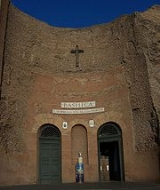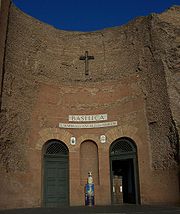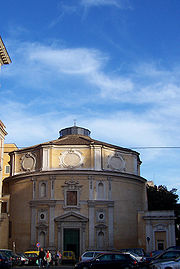
Baths of Diocletian
Encyclopedia

Ancient Rome
Ancient Rome was a thriving civilization that grew on the Italian Peninsula as early as the 8th century BC. Located along the Mediterranean Sea and centered on the city of Rome, it expanded to one of the largest empires in the ancient world....
were the grandest of the public baths, or thermae
Thermae
In ancient Rome, thermae and balnea were facilities for bathing...
built by successive emperors. Diocletian
Diocletian
Diocletian |latinized]] upon his accession to Diocletian . c. 22 December 244 – 3 December 311), was a Roman Emperor from 284 to 305....
's Baths, dedicated in 306
306
Year 306 was a common year starting on Tuesday of the Julian calendar. At the time, it was known as the Year of the Consulship of Constantius and Valerius...
, were the largest and most sumptuous of the imperial baths. The baths were built between the years 298
298
Year 298 was a common year starting on Saturday of the Julian calendar. At the time, it was known as the Year of the Consulship of Faustus and Gallus...
AD and 306 AD . The project was originally commissioned by Maximian
Maximian
Maximian was Roman Emperor from 286 to 305. He was Caesar from 285 to 286, then Augustus from 286 to 305. He shared the latter title with his co-emperor and superior, Diocletian, whose political brain complemented Maximian's military brawn. Maximian established his residence at Trier but spent...
upon his return to Rome in the autumn of 298 AD and was continued after his and Diocletian
Diocletian
Diocletian |latinized]] upon his accession to Diocletian . c. 22 December 244 – 3 December 311), was a Roman Emperor from 284 to 305....
's abdication under Constantius, father of Constantine
Constantine I
Constantine the Great , also known as Constantine I or Saint Constantine, was Roman Emperor from 306 to 337. Well known for being the first Roman emperor to convert to Christianity, Constantine and co-Emperor Licinius issued the Edict of Milan in 313, which proclaimed religious tolerance of all...
. Although many baths in and around Rome had the same elements, the Baths of Diocletian are unique by their size.
Location
The Baths occupy the high-ground on the northeast summit of the Viminal, the smallest of the Seven hills of RomeSeven hills of Rome
The Seven Hills of Rome east of the river Tiber form the geographical heart of Rome, within the walls of the ancient city.The seven hills are:* Aventine Hill * Caelian Hill...
, just inside the Agger
Agger
An agger is an ancient Roman embankment or rampart, or any artificial elevation. It is a Latin word.It is especially used for the raised and cambered embankment carrying a Roman road...
of the Servian Wall
Servian Wall
The Servian Wall was a defensive barrier constructed around the city of Rome in the early 4th century BC. The wall was up to 10 metres in height in places, 3.6 metres wide at its base, 11 km long, and is believed to had 16 main gates, though many of these are mentioned only from...
. They served as a bath for the people residing in the Viminal, Quirinal, and Esquiline quarters of the city. The Quadrigae Pisonis, a second-century monument with various reliefs, some private homes, and a relief representing the temple of Quirinus once stood at the site but were demolished to build the baths. The water supply was provided by the Aqua Marcia
Aqua Marcia
The Aqua Marcia was the longest of the 11 aqueducts that supplied the city of ancient Rome. The still-functioning Acqua Felice from 1586 runs on long stretches along the route of the Aqua Marcia....
, an aqueduct that had long served the city of Rome since the early 2nd century. To properly supply the baths, the supply of water to the city was increased under the order of Diocletian. The baths may have also been supplied by the Aqua Antoniniana, which was originally positioned to supply Caracalla
Caracalla
Caracalla , was Roman emperor from 198 to 217. The eldest son of Septimius Severus, he ruled jointly with his younger brother Geta until he murdered the latter in 211...
's baths in the early 3rd century.
History
The Baths were commissioned by Maximian in honor of co-Emperor Diocletian in 298 AD, the same year he returned from Africa. Evidence of this can be found in bricks from the main area of the baths, which distinctly show stamps of the Diocletianic period. These, according to the ancient guidebook Mirabilia Urbis RomaeMirabilia Urbis Romae
Mirabilia Urbis Romae is a much-copied medieval Latin text that served generations of pilgrims and tourists as a guide to the city of Rome. The original, which was written by a canon of St Peter's, dates from the 1140s...
, were known as "Palatium Diocletiani". This evidence shows the effect of the massive project on the brick industry in that all work by them was redirected and under control of the emperor. Building took place between the year it was first commissioned and was finished sometime between the abdication of Diocletian in 305 c.e. and the death of Constantius in July of 306 AD.
Layout
One of the four inscriptions around the main entrance to the Baths of Diocletian reads, translated from Latin, “Or Lords Diocletian and Maximian, the elder and invincible Augsti, fathers of the Emperors and Caesars, our lords Constantius and Maximian and Severus and Maximin, noblest Caesars, dedicated to their beloved Romans these auspicious Baths of Diocletian, which the divine Maximin on his return from Africa ordered to be built and consecrated in the name of his brother Diocletian, having purchased the premises required for so huge and remarkable work and furnishing them with the most sumptuous refinement.” The baths take up 120,000 square meters of the district, which is about the same size as the Baths of CaracallaBaths of Caracalla
The Baths of Caracalla in Rome, Italy were Roman public baths, or thermae, built in Rome between AD 212 and 216, during the reign of the Emperor Caracalla.- History :...
. The central hall of the baths was 280 by 160 meters and was derived from plans for the Basilica of Constantine
Basilica of Constantine
Basilica of Constantine can refer to* Basilica of Maxentius and Constantine in Rome* Basilica of Constantine in Trier...
. However, the capacity for the Baths of Diocletian was much larger in comparison. This could be because the entrance and rooms were made larger than its predecessor in block size, which allowed more space and functionality. According to Olympiodorus
Olympiodorus
There are several late-Roman figures named Olympiodorus:* Olympiodorus the Seleucid, , 2nd-century BCE high-priest in Koile-Syria and Phoinike, commissioned by Seleucus IV Philopator...
, the baths were able to hold up to 3,000 people at one time. However, this claim is disputed because Olympiodorus never mentioned how he came about this figure in the first place.
The frigidarium
The word frigidariumFrigidarium
A frigidarium is a large cold pool of Roman baths. It would be entered after the Caldarium and the Tepidarium, which were used to open the pores of the skin. The cold water would close the pores. There would be a small pool of cold water or sometimes a large Swimming pool...
originates from the Latin word frigeo, which means "to be cold". The prominence of the room and its conjoining rooms showed the increase in popularity cold baths had during the early 4th century compared to the hot baths. This also could have been a result of the depletion of the surrounding forests, resulting in a lack of fuel. The frigidarium, or Cella frigidaria consisted of a pool and a host of smaller baths connected to the main room. Water entering the room would come from a pipe or cistern and would exit through a drain within the pool. The water from the pool was thought to have been reused to flush latrines within the complex. The frigidarium was used mainly as a swimming pool or a cold-water bath, depending on the time. Normally, one would continue on to the frigidarium after using the hot-water baths or after exercising in the palaestra. Noting the massive size of the room, it was believed to have also been used as a social room. This idea is supported by the presence of statues and elaborate niches along the walls. On each end of the frigidarium are large shallow pools that were made to be open-air bathing pools.
The caldarium
The word caldariumCaldarium
right|thumb|230px|Caldarium from the Roman Baths at [[Bath, England]]. The floor has been removed to reveal the empty space where the hot air flowed through to heat the floor....
comes from the Latin word caleo, meaning "to be hot". It also has roots in the Greek word that means "innermost room". The purpose of the caldarium was that of the principle bath chamber within the baths. From its namesake, the room was used for a hot-water bath or for saunas or steam rooms. The room could have also been used for oiling before of after a bath, but, in most cases, this was moved to a separate room off of the caldarium.
The caldarium, or Cella caldaria, was rectangular in shape with many octagonal rooms found near it in the corner of the structure. The area seemed to be referencing the older baths of Nero and Titus in its initial design. What set this caldarium apart was the sheer scale of the room compared to its predecessors. It continued a basilica-like theme from the frigidarium with a cross-vaulted middle bay and three projecting apses. These architectural techniques created the feeling of a more open space for the patron. Dressing rooms, also known as apodyteria, were located on either side of the calderium. Along the sides of the caldarium were private rooms that are believed to have had multiple functions, including private baths, poetry readings, rhetoricians, etc. Other areas attached to the caldarium were a garden, lounging rooms, gymnasiums, and small halls and semicircular exedrae used as lecture and reading rooms.
Presence of libraries
A rectangular halls connected to the hemicycle have been suggested to be libraries because of their similar set-up to those in the Baths of Caracalla. Historians, to support this theory, have demonstrated that these halls with their niches could properly house books from that day. References to the presence of libraries within the baths of Diocletian both confirm and contradict themselves, such as the case of the author of the life of Probus. In it, he mentions that part of the Bibliotheca Ulpia, which are found in the Forum of Trajan, are being housed within the baths; a statement he later contradicts when later referencing the Bibliotheca Ulpia. However, with the presence of similar rooms that suggest that they were libraries found in the Baths of Caracalla and the Baths of TrajanBaths of Trajan
The Baths of Trajan were a massive thermae, a bathing and leisure complex, built in ancient Rome starting from 104 AD and dedicated during the Kalends of July in 109...
, it is not a stretch to theories to propose that the baths of Diocletian contained a library.
Architectural styles
The within the frigidarium, the use of external buttresses for the cross vaults were considered by some to be the first example of the scientific system of thrusts and counter-thrusts in architecture. Concerning the baths as a whole, it has been described as evoking the Imperial style, or a "Classical" image, which is the style of "manipulation of space". To manipulate the space within this style, the forms of the building were simple and give the impression of a vast amount of open space. The builders of the baths used different techniques to create this effect. The exterior walls of the bath were encrusted with stucco to give the impression of stonework. This technique was quite common within the structures built during the Imperial style of Roman architecture, e.g., The baths of Constantine, the Basilica Nova, and parts of the Sessorian bridge. The interior parts of the bath were supported by vaulting ceilings and arches to create curvilinear lines. The structure of the roof is a excellent example of Classical design. Architects used sloped forms to cover curved extrados (the outer surface of the arch) of the vaulted halls.Present day

- Basilica of Santa Maria degli Angeli e dei MartiriSanta Maria degli Angeli e dei MartiriThe Basilica of St. Mary of the Angels and the Martyrs is a titular basilica church in Rome, built inside the frigidarium of the Baths of Diocletian. The Cardinal priest of the is William Henry Keeler.- The basilica :...
(in the frigidariumFrigidariumA frigidarium is a large cold pool of Roman baths. It would be entered after the Caldarium and the Tepidarium, which were used to open the pores of the skin. The cold water would close the pores. There would be a small pool of cold water or sometimes a large Swimming pool...
), whose three soaring transept vaults provide one of the few glimpses of the original splendor of Roman building - the church of San Bernardo alle TermeSan Bernardo alle TermeSan Bernardo alle Terme is a basilica church in Rome, Italy.The church was built in 1598 and was initially given to a French Cistercian group, the Feuillants, through the intercession of Caterina Sforza di Santafiora. Later, after Feuillants disgregation during the French Revolution, the edifice...
(in one of the two circular rooms) - in the main hall, part of the Museo Nazionale Romano (National Roman Museum)
- the 'octagonal aula', also now part of the National Roman Museum.
Other remains of the baths are visible several streets away.
The church of San Bernardo alle Terme recycled one of only two circular towers in the rectangular boundary of the baths, flanking its southwestern wall. Between these two towers, one large exedra
Exedra
In architecture, an exedra is a semicircular recess or plinth, often crowned by a semi-dome, which is sometimes set into a building's facade. The original Greek sense was applied to a room that opened onto a stoa, ringed with curved high-backed stone benches, a suitable place for a philosophical...
used to exist as part of the same wall. Today, only its outline may be appreciated in the layout of Piazza della Repubblica.
The Smithsonian's National Museum of Natural History
National Museum of Natural History
The National Museum of Natural History is a natural history museum administered by the Smithsonian Institution, located on the National Mall in Washington, D.C., United States. Admission is free and the museum is open 364 days a year....
building in Washington, D.C.
Washington, D.C.
Washington, D.C., formally the District of Columbia and commonly referred to as Washington, "the District", or simply D.C., is the capital of the United States. On July 16, 1790, the United States Congress approved the creation of a permanent national capital as permitted by the U.S. Constitution....
was partially based on design elements from the Baths of Diocletian, including the semicircular windows
Diocletian window
Diocletian windows, also called thermal windows, are large semicircular windows characteristic of the enormous public baths of Ancient Rome...
.
Sources
External links
- Penelope.uchicago.edu, (Contains Latin translations of Historia Augusta and other primary sources)

